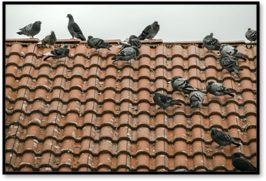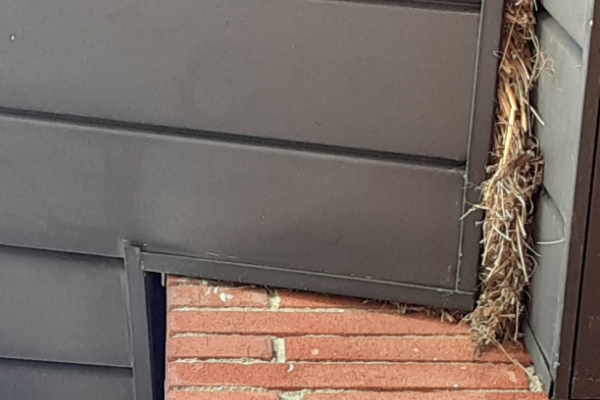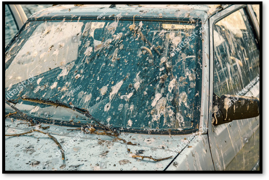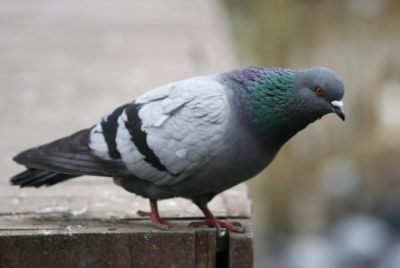Pigeon Damage (They Cause)
Even though some birds can be obnoxious, they are an important part of our environment. Among the number of bird species, pigeons have made a considerable contribution to humanity. Pigeons are entertainers for some people and trouble for others, depending on how pigeons are useful to them. If not beneficial at all, some people see pigeons as nothing more than “Rats with Wings” as they are descendants of the Wild Rock dove.
Do you ever think about why pigeons love to live in the city? The reasons are that they enjoy the luxuries in the city like free access to plenty of food and water, fewer chances to become the prey, and have lots of housing options available in the form of bridges, roofs, warehouses, and windows, etc. These birds cause tens of millions of dollars of damage every year to buildings, machinery, automobiles, roofs, ventilation systems, and much more.
Damage to the Roofs by Droppings:

Similar to other birds, pigeon droppings are acidic since they eat many substrates. Pigeon droppings on roofs, when left to accumulate, effectively wear-out most roofing material in buildings, resulting in leaks. Their droppings shorten the actual life of a roof to half, and its durability weakens. Most cases involving a roof collapse have been caused by the collection of these droppings. So, it’s an alarming sign if you see pigeons sitting on your roof for long periods.
Ventilation System Blockage:
Pigeons have been seen to build nests in ventilation systems like chimneys and block the exhaust system. This results in serious consequences, when the exhaust system is blocked, to the health of residents like death or illness because of the accumulation of increased carbon mono-oxide.
Damage to the Machinery:

The acidic nature of pigeon droppings is a serious risk to industrial machinery, insulation, sidings, etc., and can result in damaging material and stop it from working. When such damage occurs in machinery, it causes a dangerous health-risk to any worker who works around it.
Damage to Food and Chemicals:
Birds that live around stock houses, factories, airplane airstrips, and conference hall galleries can cause great destruction to these properties. Acidic droppings of pigeons can damage the plastic material on moldings; they can destroy several different chemicals and liquids when they are being manufactured. This contaminated molded plastic can poison the food packed inside and pose serious health threats, causing huge losses for manufacturing plants. Birds’ droppings and nesting material in or around a food manufacturing site shows the cleaning level of food being manufactured and packed, depicting how clean and healthy the food is.
Damage by Noise:
Pigeons make noises during all hours of the day, mostly when they are alone or in groups. When you’re happy and in a good mood they sound beautiful, but when you are not feeling good or trying to sleep, they can be annoying. This can mostly be harmful to the mental health of people with migraine pain.
Ceiling Destruction:
Pigeons are known to reside in the loft of houses, restaurants, or other buildings that have openings exposed to the outside to facilitate the bird’s entry. Pigeons set homes in these shaded areas, raise their families and discard their body’s waste. Occasionally, the accumulation of pigeon droppings can collapse a ceiling with its weight over time, but these are alarming situations.
Fire Damage from Nests
Pigeons commonly build their nest on roof corners, ceilings, drains, and rain gutters. Their nesting material is highly flammable which consists of straws and twigs, raising the chances of catching fire. This material will ignite when pigeons build their nests near electric boards, signs, or any machinery that can ignite it. The fires mostly occur with electric signs, and these sign companies blame bird nests for most of them.

Damage to Paint Finishes:
As we discussed earlier, pigeon droppings are highly acidic and cause damage to many things. This acidic nature of droppings has been found to cause the fading of paint finishes of vehicles. The droppings fade the paint by penetrating deep into the protective coating and paint itself. If droppings are not cleaned after a long period on the paint, it will do more damage to the vehicle sheet too.

Damage by Spreading Disease
Pigeon droppings are the source of diseases spread. We all understand we should not handle pigeon droppings barehanded as it contains many disease pathogens. Even the dried droppings that turn into powder and blow in the wind can transfer disease pathogens. Inhalation of this powder transmits diseases from pigeons to humans. The most common transferred pathogens are E. coli, St. Louis encephalitis, Histoplasmosis, and Candidiasis which results in severe muscle fatigue, inflammation of the nervous system, respiratory problem, and food poisoning respectively. Pigeons are also carriers of mites, fleas, and the West Nile Virus, which are potential human health hazards.

